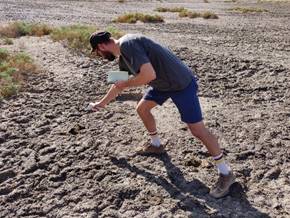|
|
|
UW
Astrobiology Workshop: Death Valley 2018 Jana Meixnerová, ESS
Department In later October 2018, 12 graduate students and 4
senior staff members of the UW Astrobiology participated in a three-day UWAB
workshop in Death Valley, CA. The purpose of the trip was to study the
geologic record of Neoproterozoic to Cambrian environmental transition,
observe geological structures related to tectonic activity in the area, and
obtain DNA samples from various locations within the national park for
subsequent processing at UW with the new Nanopore sequencer. These field
experiences familiarized students with the co-evolution of life and surface
environments on the early Earth, offered a perspective on what observations
of geologic structures on the surface of a planet can tell us about its
activity and potential for life, and provided a hands-on example of life in
extreme environments. The UW Astrobiology group was accommodated at the
Shoshone Educational And Research Center (SHEAR) in Shoshone, CA. SHEAR has
served for decades as a community shelter to students conducting geologic
mapping and investigations in the Death Valley region; our stay at the by now
legendary residence was facilitated by the trip co-leader, Prof. Darrel
Cowan, structural geologist and an expert on Death Valley of the UW ESS
Department. On our first night we were generously hosted for Mexican dinner
at the local Crowbar & Saloon, our subsequent evenings were spent with
discussions and games in the SHEAR hub.
Figure 1: Our drive from Las Vegas to Shoshone rendered
some spectacular views of the range-and-valley landscape with well-exposed,
colorful stratigraphic layers, leaving the geologists among us in state of
exhilaration and awe.
Figure 2: Based on close observations of modern
analogues close to Dumont Dunes, students discussed the role of mud cracks
and desiccation features in inferring the geologic history of Mars. Figure 3: Prof. At the Kingstone Peak
Figure 4: We learned about the biota of the Proterozoic
Eon while studying the stromatolites of the 1.2 billion years old Crystal
Spring Formation.
Figure 5: Jana Posing with the exceptionally
well-exposed normal fault at the Frontal Fault Canyon. Crustal spreading in
the region triggers recurrent seismic activity and faulting of the rocky
mountain ranges.
Figure 7: Measurements
of the temperature of the host soil were part of the data collection during
soil sampling. Here, graduate student Michael Kipp takes careful temperature
recordings.
Figure 8: Where else to have a discussion about life in space than in one of the
most extreme environments on Earth? Figure 9: The Badwater Basin,
lowest point of Death Valley and North America, covered by vast salt
deposits, crystallized into hexagonal honeycomb shapes. Students collected
further soil samples here, close to the Badwater spring-fed pool.
Figure 10: At Devil’s Golf Course, salt had
crystallized into mysterious structures. Prof. Roger Buick attempted to
answer our questions about their origin.
Figure 11: The path to our next sampling location, the
Salt Creek, was laminated by the succulent pickle leaf and surrounded by
otherworldly sedimentary lake deposits.
Figure 12: The view of Badwater basin from Dante’s
view.
Figure 13: Sunset over Death Valley as observed from
Dante’s View.
Figure 14: On our way back to Las Vegas, we
investigated ancient animal burrows in the Cambrian Zabriskie quartzite.
These trace fossils are indicative of the new age of bioturbation and
sediment ventilation after the Cambrian explosion 541 million years ago.
Adjacent to the Zabriskie Quartzite outcrops the fossiliferous Wood Canyon
shale, where we searched for Ediacaran to Cambrian trilobite fossils and
learned about trilobite morphology. Overall, the Death Valley workshop was perceived by its
participants as a great success! The field observations and accompanying
debates satisfied our scientific curiosity, and the group travel and time
spent at SHEAR facilitated further bonding of our great community of students
and researchers. By the end of the trip, we could not stop talking about the
next AB workshop!
Figure
15: The entire ‘dream team’: All participating graduate students, post-doc
Kim Bott, and instructors Prof. Roger Buick and Prof. Darrel Cowan. |
|
|
|
THIS E-NEWSLETTER WAS SENT BY:
|
















